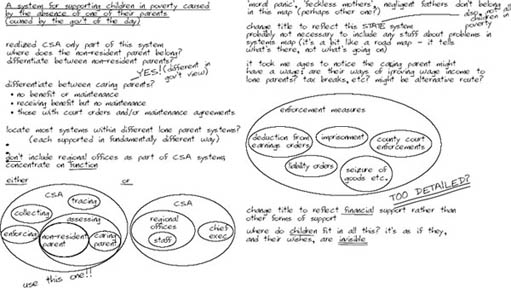9.2 Systems maps: searching for system
A simple definition of a system is an assembly of components interconnected as if they had a purpose. I am going to use the idea of purpose to look at the situation as I understand it.
Presented with the complexity of this situation it may be hard to know where to start. I have often found it helpful to start with the notion that somewhere in all this complexity there is, or was, some purpose. It is quite common in situations like this to find the mess has arisen because somewhere at some time someone had a purpose, tried to achieve it, but their intentions got lost in the unintended consequences of what they did. In the following activity, try to find as many answers as possible in the time.
Take about 10 minutes to do this activity.
Activity 17
What was the perceived problem (or opportunity) to which components in this situation seemed to offer a solution?
Identify at least two organisations, processes, activities or ideas in the situation that might be perceived as attempted solutions to some issue, problem or opportunity. Preferably, identify several more.
Identify the issues, problems or opportunities to which these might be said to be attempted solutions.
For each of these issues, suggest the person, persons, or organisation that had the power to bring each of these attempted solutions into being.
Discussion
This question, and others like it, seems to offer a powerful way into understanding the situation. First, it prompts me to ask what components in the situation have been brought into the situation by conscious design. I am then prompted to ask who brought them in and why. The question Why? thus leads me to some conception of purpose within the situation, and the Who? identifies potential owners of the solutions.
I can exemplify the way this question enables me to make these distinctions. Please don't assume this example answer is a model answer, let alone the right answer. As you will see, the answers I identify are constructions I put on the situation – they are not, in this case, directly drawn from the case study material. Sometimes in complex situations purpose is explicitly stated, but more usually it has to be inferred.
Within the case study material, I can identify a number of elements that have been brought into the situation by human agency. The first one that struck me was the Department of Social Security. The DSS was brought into being well before the events that led up to the current situation. I can also infer, even if I do not know, a number of purposes may have been present at the time it was set up: the provision of social security for the citizens of the UK; the alleviation of poverty within the UK; the redistribution of income. It is possible a number of purposes were present, both implicit and explicit. I can infer that, as a government department, it was set up by a past government perhaps acting on behalf of the electorate. In this case, the DSS seems to be rather peripheral to the situation described in the case study. It is likely that exploring other, more central, entities will produce more insights. The Child Support Agency and the Child Support Act are more obviously central to the situation.
Spend about five minutes on the following activity.
Activity 18
Identify a potential system-with-purpose from your previous notes.
Rewrite each issue statement you identified in Activity 17 in terms of a system intended to address the issue. For example, an issue framed in terms of ‘a perceived need to encourage responsible parenting’ becomes ‘a system to encourage responsible parenting’.
Check the system you have identified is one the system owner could have seen, in principle at least, as being represented by the entity in the system they introduced. If not, look again at the possible problem you identified. Notice there is no need to establish whether the system actually worked, or whether it actually exists today.
The process you just went through for each of these systems is illustrated in Figure 9. Figure 9 is one possible schema for finding a system through which to explore a complex situation. I can refer to such a system as a system of interest. A system of interest is one on which a systems thinker chooses to focus their interest.

The output from these activities is a list of systems and their owners. At this stage, there is no judgement about whether these systems actually exist in the situation; about whether they work; about their desirability; nor about their relevance to the purposes of their owners. They are lenses through which to look at the situation. I can now ask myself: if there is a system whose purpose is, say, to encourage responsible parenting, then what relationship do other entities in the situation have to this system, and to each other?
